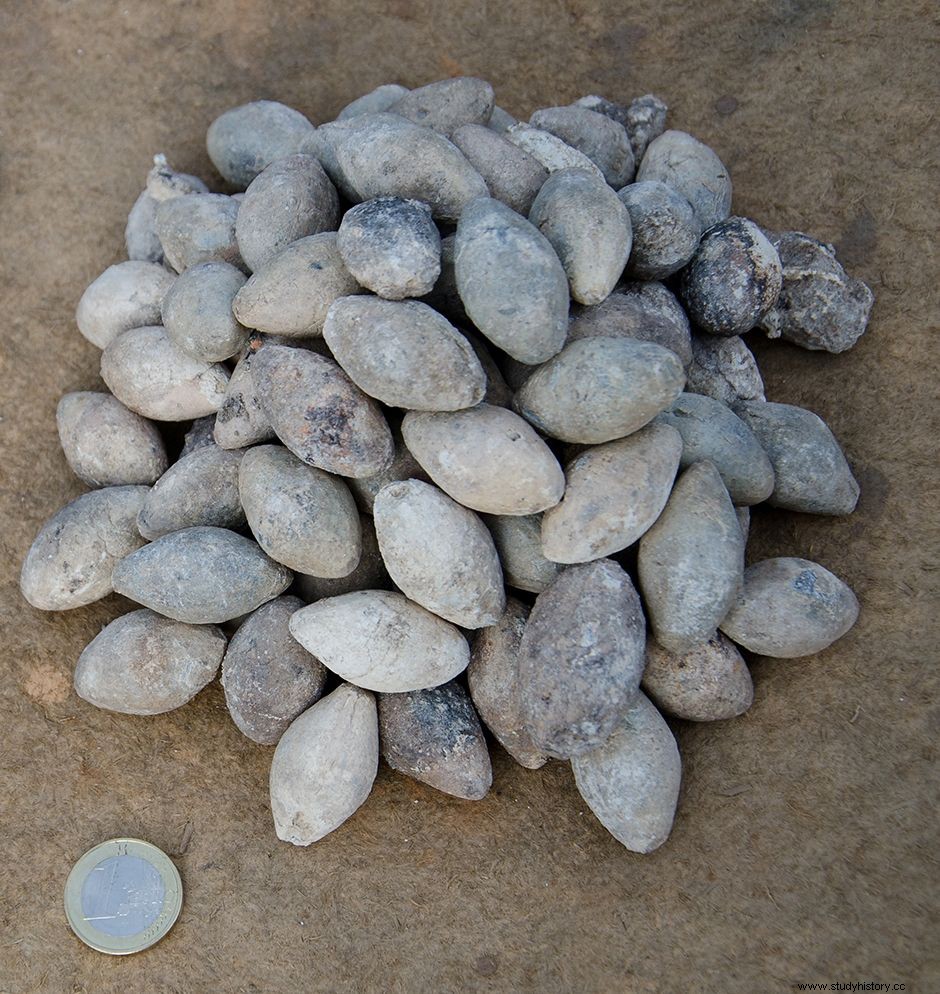 This pile of 81 lead projectiles with an average weight of 75 grams was found in Westphalia.
This pile of 81 lead projectiles with an average weight of 75 grams was found in Westphalia. DIGITAL. Article taken from the monthly Sciences et Avenir n°822, available on newsstands until August 26, 2015.
SLING. It looks like just a pile of "pebbles"... but a treasure trove for archaeologists, who today wonder who could have hidden them so carefully underground. A weary soldier, tired of bending over under his too heavy gear? Or scrapping his stockpile of ammunition to get a new one? Buried for 2000 years in a ditch of the old Roman camp of Haltern, in Westphalia (Germany), these six kilos of lead are indeed "acorns", in other words 81 ammunition for slings which the Roman armies used, like all those of the time. And the camp of Haltern is known to have hosted many legions sent to Germania to subject the rebellious peoples to Roman colonization.
Sometimes more effective than arrows
The most famous of these, the 19th Augusta Legion, was annihilated by the Germans in 9 CE in the Teutoburg Forest, about 200 kilometers from the camp. This is not the first time that archaeologists have found these lead balls. Several were collected in Alesia, Burgundy, where the Gallic coalition led by Vercingetorix was defeated by Caesar. "The sling was widely used throughout antiquity" , explains the historian Yann Le Bohec (Paris-Sorbonne University). This long-range weapon, called "funda", indeed caused great damage in the opposing troops. "Despite their armour, soldiers are often more hampered by slingshot bullets than they are by all the enemy's arrows. Stones kill without maiming the body or shedding blood" , reports the Roman historian Végèce (4th century) in his treatise on military tactics, De re militari . "The slingers intervened with the archers and javelin throwers, before the legionnaires engaged in hand-to-hand combat, thus tiring the enemy by causing him many casualties, continues Yann Le Bohec. During the Gallic Wars, for example, a Caesar's legate had his jaw blown off by a sling shot fired by a Gaul."

This pile of 81 lead projectiles with an average weight of 75 grams was found in Westphalia (©LWL/BURGEMEISTER).
These elite soldiers, able to aim accurately at almost 200 meters according to Végèce, were highly sought after and, under the Republic, Rome would even recruit them as far as the Balearic Islands. Conscious of their strength, they sometimes engraved messages on acorns which they sent to the enemy, the name of their general, ritual formulas or threats... Thus, during the siege of Athens, in 86 BC, the Greek soldiers in the service of the Roman general Sylla had warned the Athenians of the fate they intended to inflict on their wives after the victory...
Did the "bag of marbles" found at Haltern really belong to a soldier of the XIX Legion? In any case, it was during this period that the camp was abandoned by the Romans... And we thus find ourselves imagining that these 81 sling bullets may have been hastily thrown by a legionnaire in a hurry to lighten up to save his life during the evacuation of the camp.
